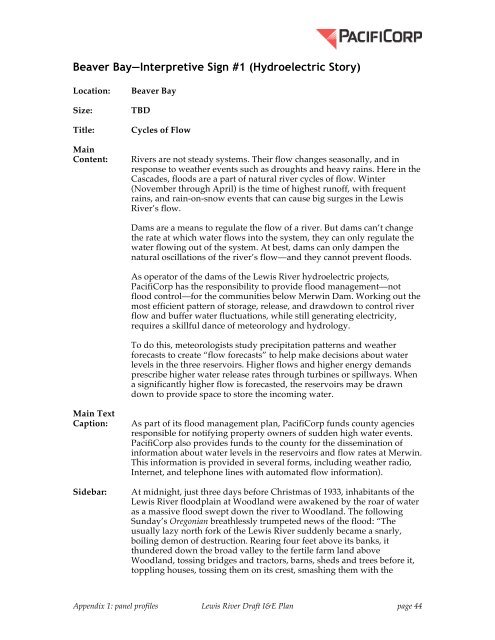The Lewis River Hydroelectric Projects - PacifiCorp
The Lewis River Hydroelectric Projects - PacifiCorp
The Lewis River Hydroelectric Projects - PacifiCorp
You also want an ePaper? Increase the reach of your titles
YUMPU automatically turns print PDFs into web optimized ePapers that Google loves.
Beaver Bay—Interpretive Sign #1 (<strong>Hydroelectric</strong> Story)<br />
Location:<br />
Size:<br />
Title:<br />
Main<br />
Content:<br />
Beaver Bay<br />
TBD<br />
Cycles of Flow<br />
<strong>River</strong>s are not steady systems. <strong>The</strong>ir flow changes seasonally, and in<br />
response to weather events such as droughts and heavy rains. Here in the<br />
Cascades, floods are a part of natural river cycles of flow. Winter<br />
(November through April) is the time of highest runoff, with frequent<br />
rains, and rain-on-snow events that can cause big surges in the <strong>Lewis</strong><br />
<strong>River</strong>’s flow.<br />
Dams are a means to regulate the flow of a river. But dams can’t change<br />
the rate at which water flows into the system, they can only regulate the<br />
water flowing out of the system. At best, dams can only dampen the<br />
natural oscillations of the river’s flow—and they cannot prevent floods.<br />
As operator of the dams of the <strong>Lewis</strong> <strong>River</strong> hydroelectric projects,<br />
<strong>PacifiCorp</strong> has the responsibility to provide flood management—not<br />
flood control—for the communities below Merwin Dam. Working out the<br />
most efficient pattern of storage, release, and drawdown to control river<br />
flow and buffer water fluctuations, while still generating electricity,<br />
requires a skillful dance of meteorology and hydrology.<br />
To do this, meteorologists study precipitation patterns and weather<br />
forecasts to create “flow forecasts” to help make decisions about water<br />
levels in the three reservoirs. Higher flows and higher energy demands<br />
prescribe higher water release rates through turbines or spillways. When<br />
a significantly higher flow is forecasted, the reservoirs may be drawn<br />
down to provide space to store the incoming water.<br />
Main Text<br />
Caption:<br />
Sidebar:<br />
As part of its flood management plan, <strong>PacifiCorp</strong> funds county agencies<br />
responsible for notifying property owners of sudden high water events.<br />
<strong>PacifiCorp</strong> also provides funds to the county for the dissemination of<br />
information about water levels in the reservoirs and flow rates at Merwin.<br />
This information is provided in several forms, including weather radio,<br />
Internet, and telephone lines with automated flow information).<br />
At midnight, just three days before Christmas of 1933, inhabitants of the<br />
<strong>Lewis</strong> <strong>River</strong> floodplain at Woodland were awakened by the roar of water<br />
as a massive flood swept down the river to Woodland. <strong>The</strong> following<br />
Sunday’s Oregonian breathlessly trumpeted news of the flood: “<strong>The</strong><br />
usually lazy north fork of the <strong>Lewis</strong> <strong>River</strong> suddenly became a snarly,<br />
boiling demon of destruction. Rearing four feet above its banks, it<br />
thundered down the broad valley to the fertile farm land above<br />
Woodland, tossing bridges and tractors, barns, sheds and trees before it,<br />
toppling houses, tossing them on its crest, smashing them with the<br />
Appendix 1: panel profiles <strong>Lewis</strong> <strong>River</strong> Draft I&E Plan page 44
















